Interactivity in eLearning instructional design takes many shapes and forms. Interactive elements are essential to elearning courses as they help engage learners and hold their attention. Furthermore, interactivities also serve functional purposes that aid the learning process. By adding interactivities, you can facilitate active learner participation and reduce the monotony of the courses you build. There are 4 levels of interactivity in eLearning instructional design that you can opt for. Each level is more interactive than the previous one and you can pick the one that best fits your learning objectives, budget, and timeline. This article will walk you through each of these 4 levels of interactivity and delineate the common interactions found in them.
Table of Contents
The 4 levels of interactivity in eLearning instructional design are:
- Passive interaction
- Limited interaction
- Moderate/complex interaction
- Simulation and game-based interaction
Level 1: Passive Interaction
This level is the least interactive of the 4. Level 1 courses feed information to learners in a way that only requires their passive involvement. They can only watch or read the information presented to them without performing any extra functions on them. Learners are passive receivers of knowledge, so to speak.
Such courses have the following characteristics:
- A linear format without much navigational freedom apart from clicking to move forward or backward
- Static text and graphics
- A voiceover to accompany the text and graphic information
Because the primary form of interaction in these courses is clicking forward and backward, level 1 elearning modules are also called “click-next” or “page-turner” courses.
The elements found in level 1 courses are:
- Directional navigation buttons
- Images, tables, and texts without animations
- External links to supplementary content such as podcasts, videos, PDF downloads, etc.
- Very simple assessment questions such as true and false and MCQs
Level 1 interactivity in eLearning instructional design is best used when you are low on resources and time and the subject matter is simple to understand
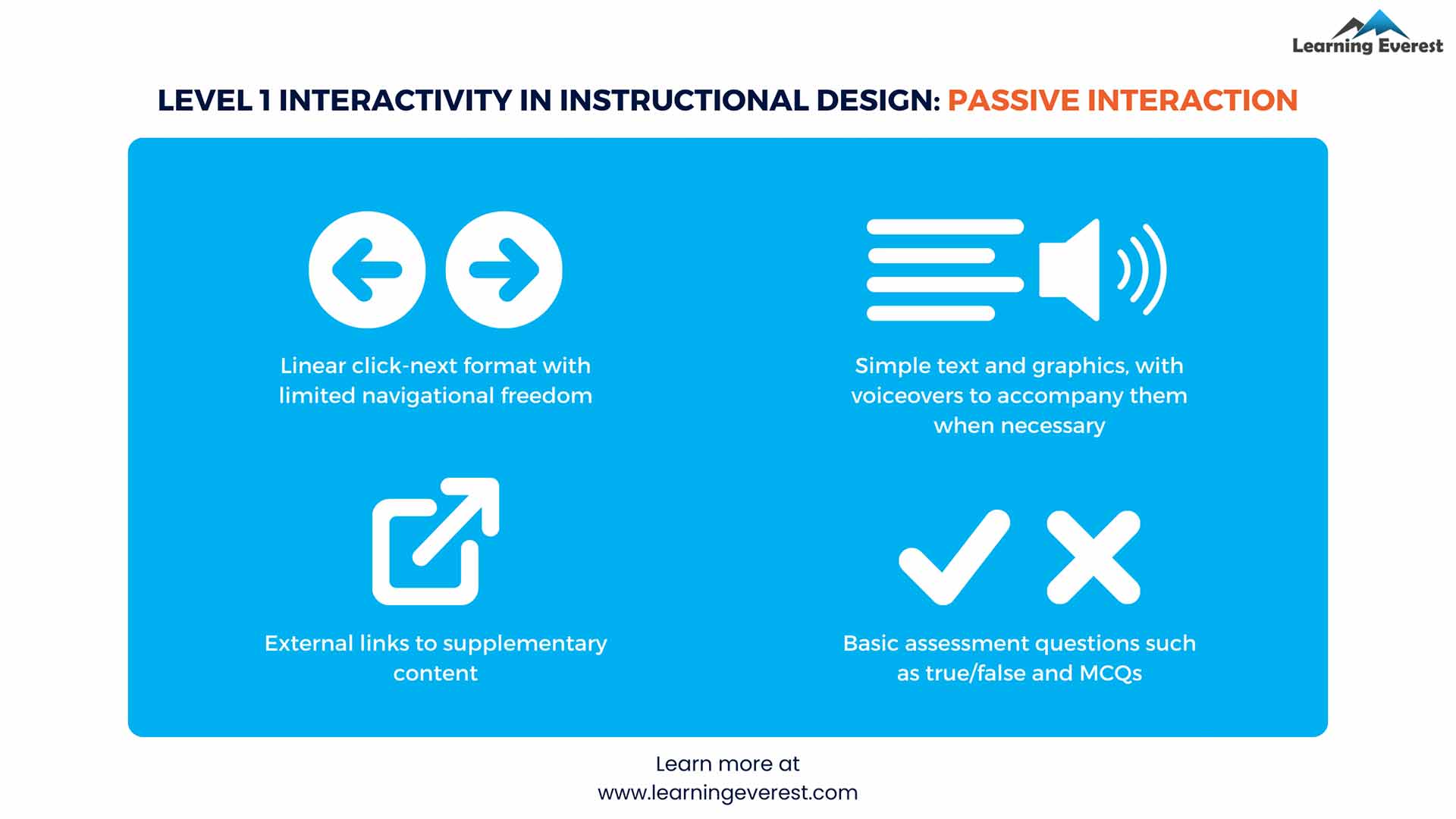
Level 1 Interactivity in Instructional Design – Passive Interaction
Level 2: Limited Interaction
Things become more actively engaging at this level. While the interactions found at this level are basic compared to higher levels, the range of interactivities increases.
Learners have more navigational freedom through elements like menus and they can perform limited functions such as drag-and-drop and click-to-reveal exercises. Additionally, text is replaced with multimedia elements such as diagrams, graphics, videos, and audio. A level 2 course can also have personalized avatars for each learner.
To summarize, the elements commonly seen in level 2 courses are:
- Menus with open navigation instead of locked, linear navigation
- Activities that require learners to perform functions such as drag and drop, matching, timelines, click and reveal, etc.
- More advanced assessments that incorporate the activities mentioned above
- Videos, audio, and interactive graphics and diagrams
- Personalized learner avatars
The most common use of level 2 courses in eLearning instructional design is for reinforcement and revisions modules that assess learner recall and brush up their memories.
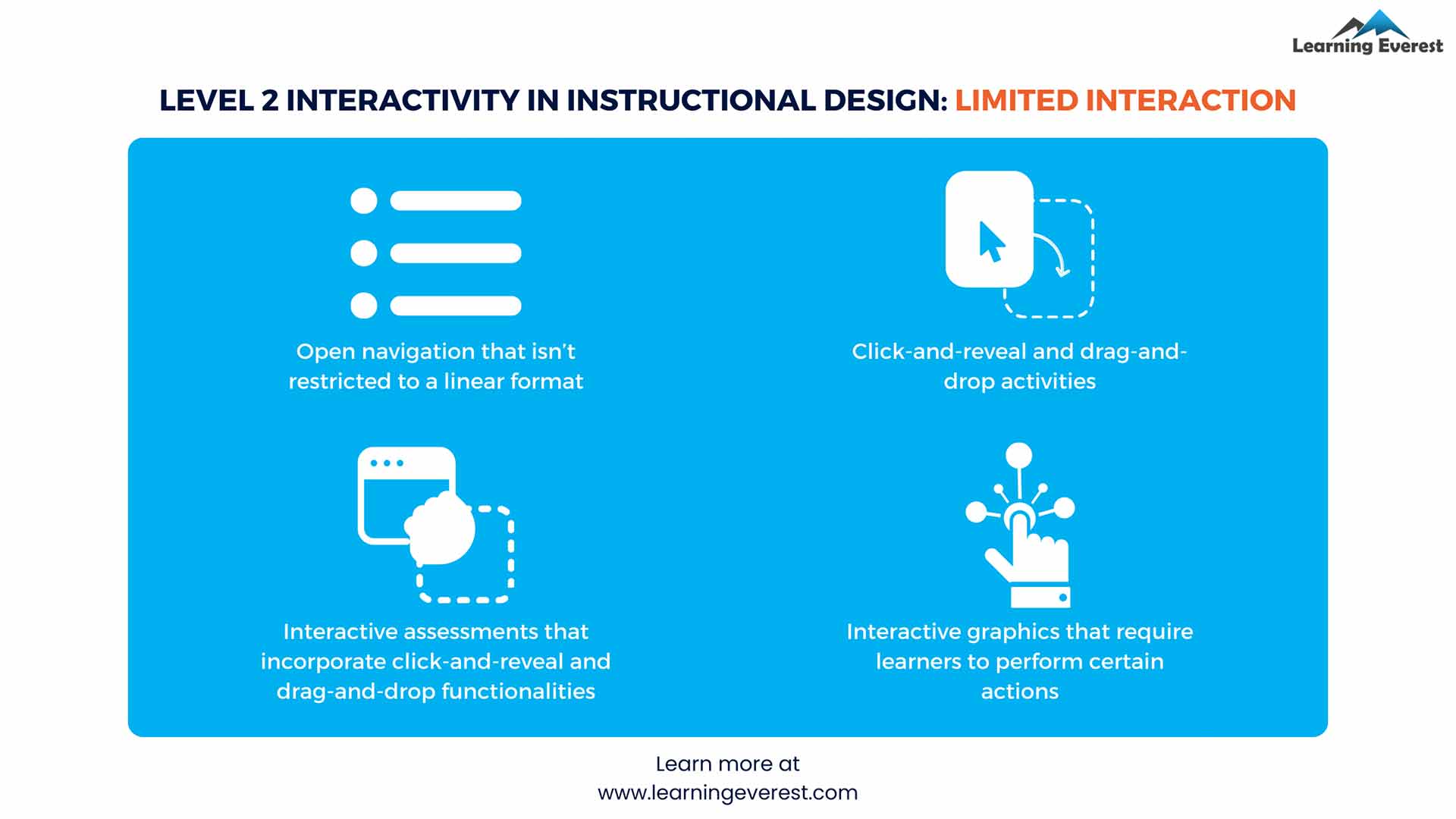
Level 2 Interactivity in Instructional Design – Limited Interaction
Level 3: Moderate/Complex Interaction
In level 3, the learners participate actively in the learning process through interactivities. The interactions in this level are complex and require mental and emotional involvement from learners. In other words, level 3 interactivities are more rigorous.
Aspects like narratives, scenarios and role-plays are introduced in level 3. Additionally, assessments become more complex and might require learners to enter answers themselves instead of picking from a pool of options.
Thus, elements used in level 3 courses are:
- Stories, comic strips, and other empathy-inducing techniques
- Assessments that require learners to think of answers
- Videos and audios like level 2 courses
- Scenarios
- Characters learners can identify with
Level 3 courses are commonly used for complex training areas and are a favorite among L&D departments for the level of engagement and learner participation they provide.
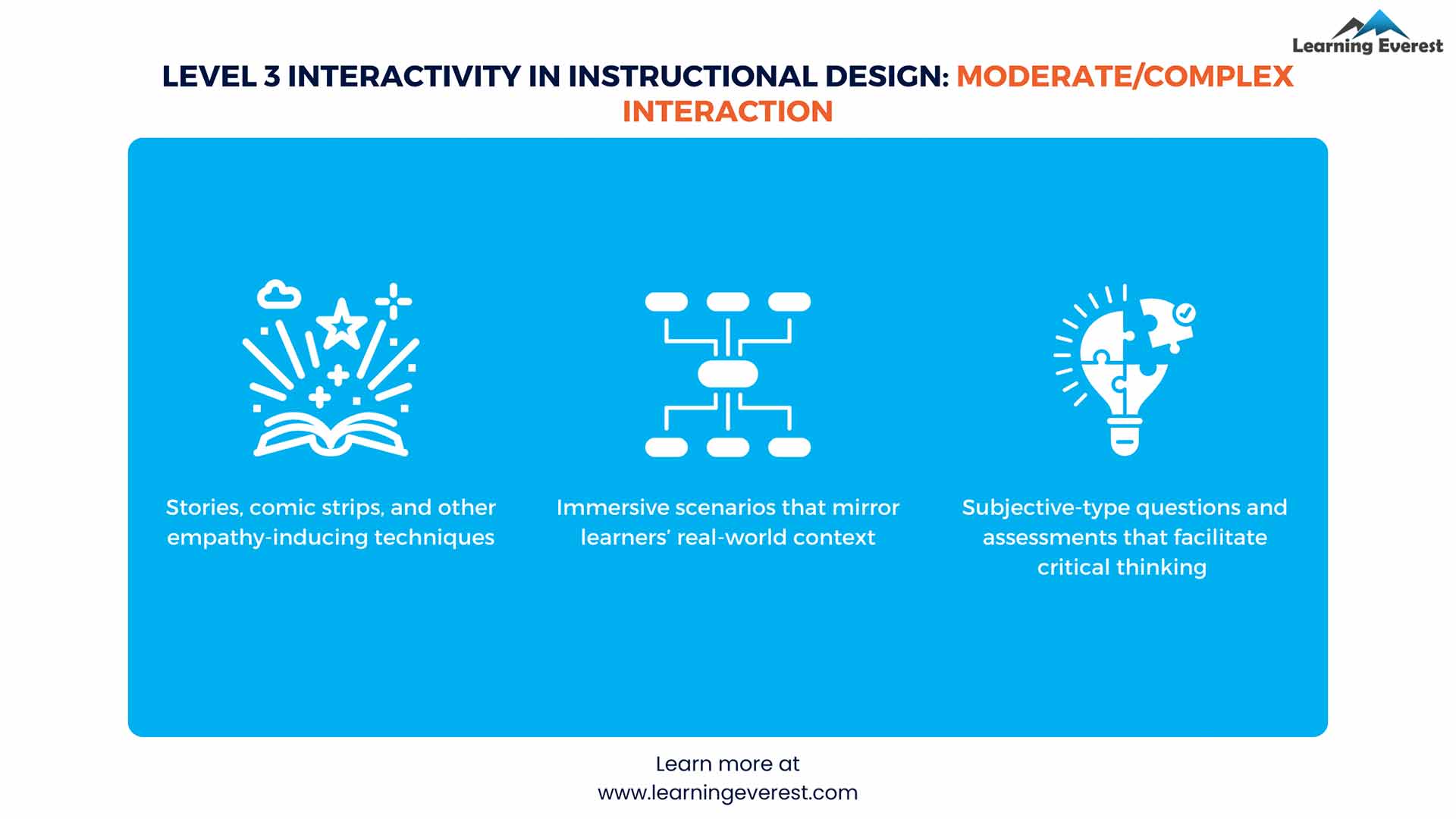
Level 3 Interactivity- Moderate to Complex Interactions
Level 4: Simulation and Game-Based Interaction
This is the highest level of interaction in eLearning instructional design. This kind of interaction allows learners to perform a full range of actions during learning activities and creates real-time practice opportunities.
Simulations and gamification are the most common modes in which level 4 courses are delivered. While gamification elements are present in level 3 courses as well, in level 4 courses gamification extends beyond assessment activities. For instance, different action sequences might be taught using game-based learning instead of simply testing the learner’s recall of said sequence.
Simulations are another common way to impart knowledge to learners. Simulations involve virtual settings that mimic real-world environments and might incorporate narratives to give some structure to the course.
AR/VR, gaming technology, 3D models of objects and places, realistic avatars, etc. are all elements used in level 4 courses.
Naturally, level 4 courses are the most expensive and time-consuming to produce but they are also the most effective when used for the right training needs. It is best for complex skill-building and fields where learners’ actions can have serious real-world consequences such as healthcare and aviation. Level 4 courses are also great for teaching technical and mechanical skills that require taking apart, putting together, and servicing objects and gadgets.
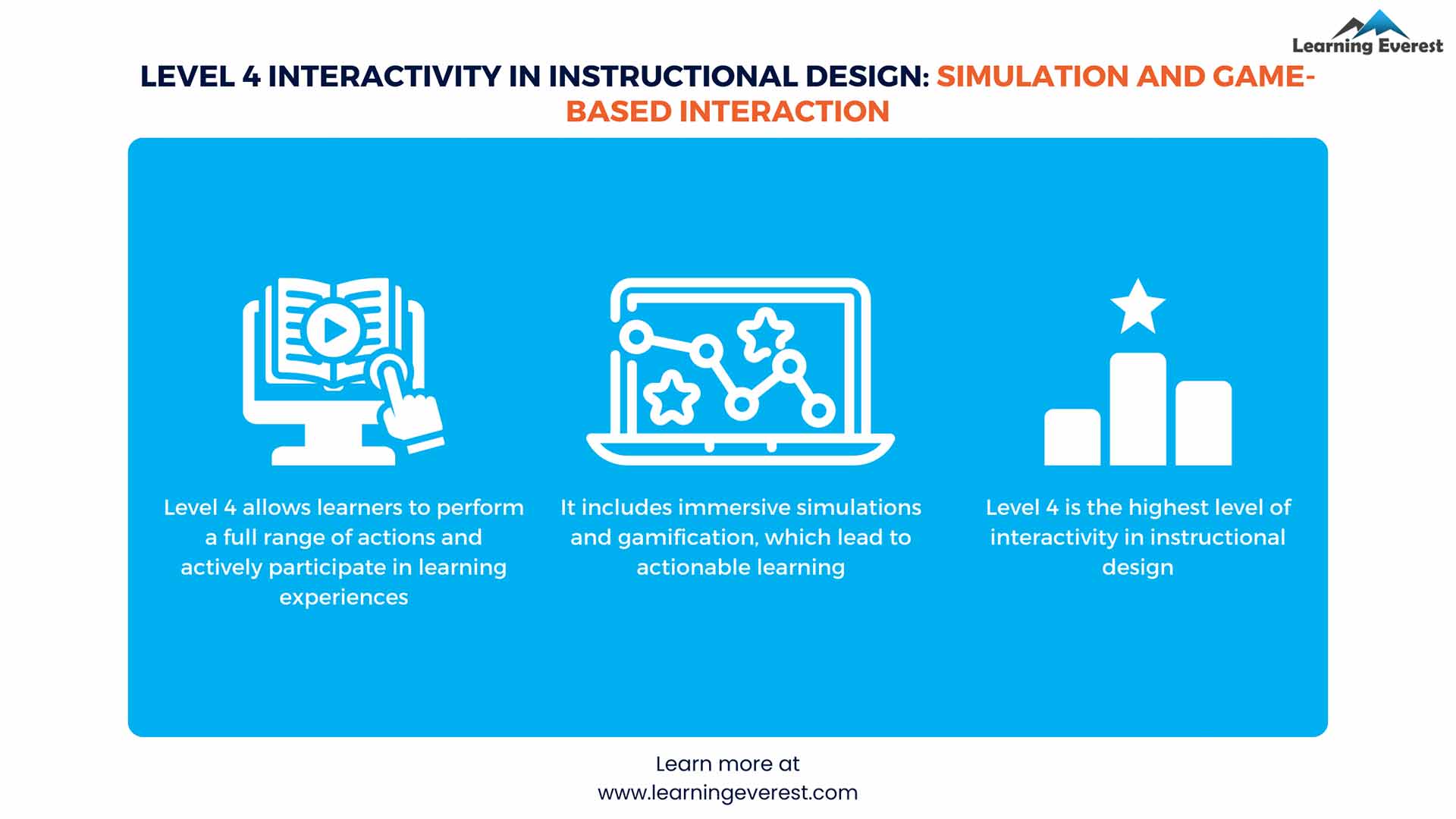
Level 4 Interactivity in Instructional Design – Simulation And Game-Based Interaction
Infographic
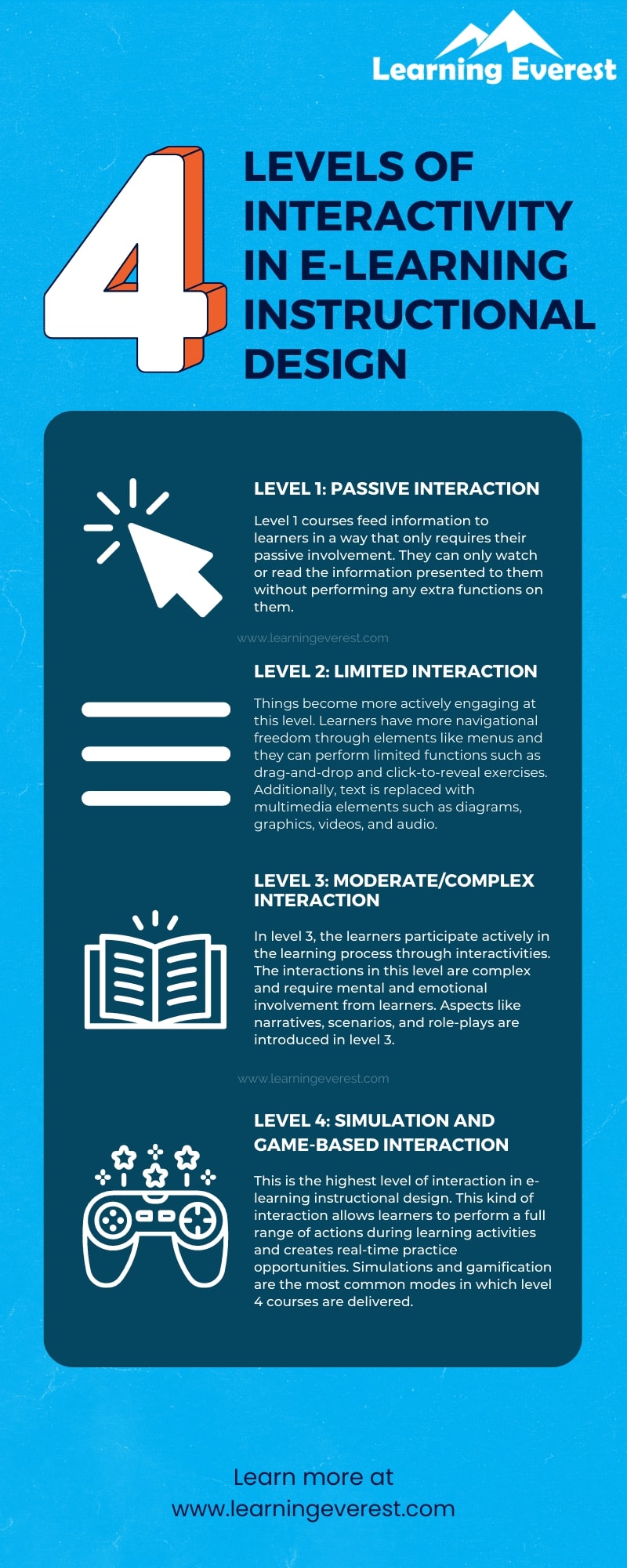
4 Levels of Interactivity in eLearning Instructional Design
Knowledge Check!
Conclusion
Ultimately, the right level of interactivity for your elearning instructional design will depend on your desired outcomes, training area, target learners, budget, and the time available to build a course. Each level has pros and cons and areas where they excel and it is up to instructional designers to make the right call regarding the correct approach to use.





